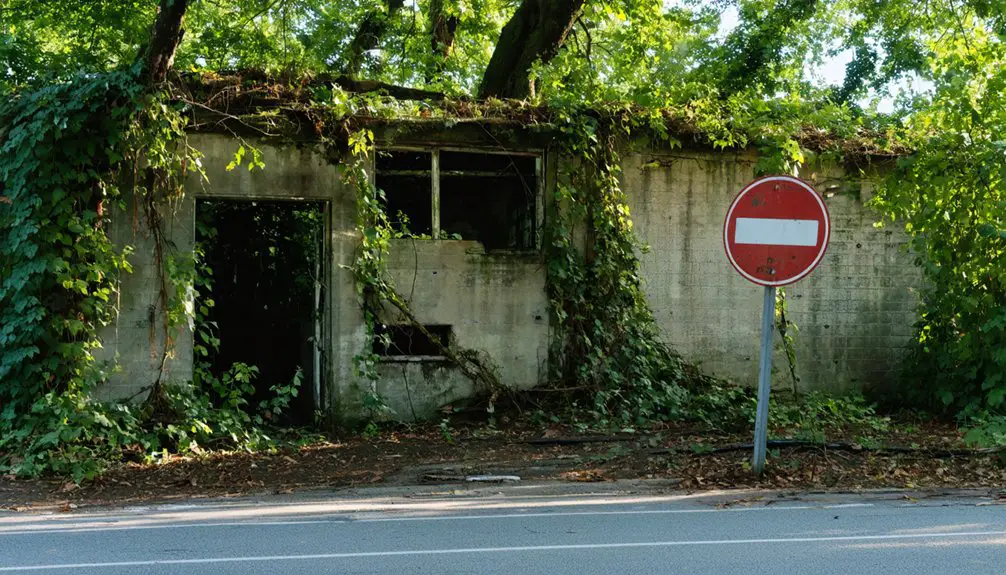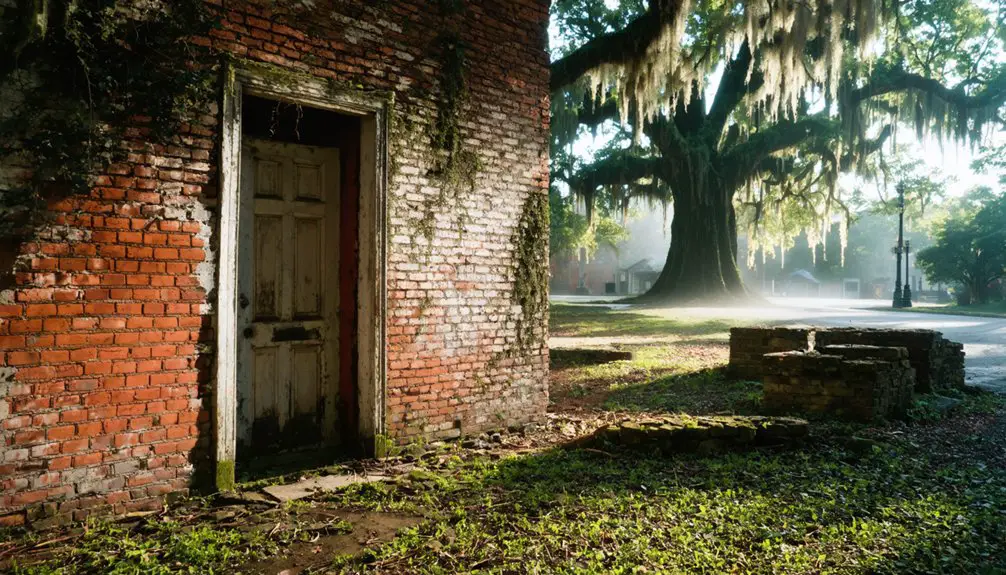You’ll find Virginia’s mysterious Elko Tract ghost town in eastern Henrico County, where a secret WWII decoy airfield once protected Richmond’s Byrd Field. The 936th Camouflage Battalion transformed 2,400 acres into a fake military installation, complete with dummy planes and false runways. After the war, failed plans for a segregated mental hospital left the site abandoned. Today, urban explorers discover crumbling infrastructure and overgrown streets while local legends hint at deeper mysteries beneath the forest canopy.
Key Takeaways
- Elko Tract is an abandoned 2,400-acre site in Virginia that served as a secret WWII decoy airfield to protect Byrd Airfield.
- The 936th Camouflage Battalion created fake runways, buildings, and aircraft using timber and canvas to deceive enemy bombers.
- A failed 1947 mental hospital project left infrastructure remnants, including abandoned streets and a rusting water tower.
- The site is now an overgrown ghost town, with crumbling roads and deteriorating structures beneath encroaching forest.
- Urban explorers visit the tract to document its haunting remains, while local legends tell tales of secret bunkers and military operations.
The Secret World War II Decoy Airfield
During World War II, the U.S. military constructed an elaborate decoy airfield in Virginia’s Elko Tract as part of a strategic defense plan to protect Richmond’s critical Byrd Airfield.
The 936th Camouflage Battalion seized 2,400 acres of farmland and rapidly transformed it into a sophisticated wartime deception site just five miles from the real facility.
You’ll find that these decoy tactics were remarkably detailed. The site featured three fake runways matching Byrd Airfield’s layout, complete with working lights to fool enemy bombers flying at 20,000 feet.
The battalion crafted dummy planes, artillery pieces, and buildings from timber, canvas, and plywood. They even replicated Richmond’s street grid to create a “false city” around the airfield. When bomber alerts occurred, Richmond’s power shut off while the decoy site illuminated to deceive potential attackers.
Using simple materials like wood and canvas, soldiers built an entire fake world of planes, weapons and city streets.
The Engineer Aviation Battalion maintained and operated the decoy field from September 1943 to March 1944.
While enemy forces never attacked Richmond, the site stood ready throughout the war as a proof of military ingenuity.
Abandoned Mental Hospital Project
After the war ended, the Elko Tract’s military deception gave way to a different kind of social deception. In 1947, Virginia planned to build a segregated healthcare facility for African-American mental patients, investing $500,000 in infrastructure including streets, drainage systems, and a water tower. The facility was similar to Central State Hospital, which had already been treating Black patients since 1870.
You’ll find that local resistance was fierce from the start. Henrico County residents and legislators fought against the hospital’s location, their opposition deeply rooted in racial prejudices of the era. Residents expressed “hot opposition” to the proposal in February 1947.
By 1957, institutional neglect and community pressure led the governor to redirect the project to Petersburg, leaving Elko’s development abandoned.
Today, you can still see the physical remnants of this failed project – overgrown streets, sidewalks with trees growing through them, and a rusting water tower stand as stark reminders of Virginia’s segregated past.
What Remains Today: Urban Exploration
Today, intrepid urban explorers venture into Elko Tract’s haunting remains, where nature steadily reclaims the vestiges of wartime deception and postwar abandonment.
While historical preservation efforts struggle against time, you’ll discover a mysterious landscape where exploration challenges include maneuvering overgrown streets and deteriorating infrastructure.
Originally built by the 936th Camouflage Battalion, this site represents a remarkable piece of military ingenuity from World War II.
As you traverse this forgotten landscape, you’ll encounter:
- Grid-patterned streets now shrouded by thick vegetation, with trees bursting through cracked sidewalks
- A rusted water tower that serves as a silent sentinel above the decaying cityscape
- Faint outlines of false runways beneath the forest canopy, echoing the site’s WWII-era mission
Despite official restrictions, urban explorers continue documenting this unique slice of military history, even as Richmond’s eastward expansion threatens to permanently erase these atmospheric ruins.
Local Myths and Urban Legends
Local myths about Elko Tract have flourished alongside its physical ruins, transforming this former military installation into a rich tapestry of urban legends.
You’ll hear ghost stories about secret underground bunkers and alien research facilities, though these claims lack documentary evidence. The site’s most enduring legend centers on its role as a World War II decoy city, designed to fool enemy bombers by mimicking Richmond’s layout while the real city maintained blackout conditions.
Local folklore has also woven racial and social elements into the tract’s mystique, particularly regarding the unrealized plans for an African-American mental hospital in the post-war era.
While many of these tales blend fact with fiction, they reflect the community’s attempt to make sense of this abandoned landscape and its complex military and social history. During World War II, the 936th Camouflage Battalion expertly constructed fake runways and buildings to create a realistic decoy airfield that could deceive potential enemy attacks.
Historical Impact on Virginia’s Landscape
During World War II, Elko Tract’s transformation into a decoy airfield permanently altered Virginia’s landscape, creating a unique military-industrial footprint that still influences the region.
You’ll find evidence of both human displacement and landscape resilience in this fascinating slice of wartime history. The farming community takeover forced residents to abandon their homes and livelihoods when the military seized control.
Today, the land tells a compelling story through:
- Abandoned infrastructure including a rusted water tower, overgrown roads, and defunct sewage facilities that showcase nature’s reclamation
- Failed development attempts, from the unfinished segregated mental hospital to blocked access roads
- A naturally rewilded environment where trees break through concrete and forest overtakes former military installations
These physical remnants serve as a powerful reminder of how military strategy, civil rights struggles, and environmental forces have shaped Virginia’s geography over eight decades, creating an unintentional monument to change and adaptation.
Frequently Asked Questions
Are There Any Documented Accidents or Deaths at Elko Tract?
Like an old-school Netflix drama, you’ll find two confirmed fatal crashes on Elko Tract Road – one in 1983 and another recent incident. Local legends hint at more, but historical significance lacks documented proof.
What Is the Current Ownership Status and Future Development Plans?
You’ll find Henrico County owns the land currently, with active plans to attract manufacturing and tech businesses. They’ve invested $40 million in infrastructure to position the tract for future industrial development.
How Many Original Structures From the Decoy Airfield Still Exist?
Presently, you’ll find practically zero preserved pieces from the past – no original structures remain standing. While historically significant runways were visible in 1994, they’ve largely vanished beneath forest growth today.
Has Any Paranormal Activity Been Scientifically Investigated at the Site?
You won’t find any scientifically validated paranormal research at this location. While ghost sightings are frequently reported by urban explorers, there’s no documented evidence from controlled studies or professional investigations.
What Wildlife Species Have Taken Over the Abandoned Property?
While humans abandoned this haven, you’ll find nature’s resurgence through white-tailed deer, Virginia opossums, woodchucks, flying squirrels, and diverse bird species thriving in this accidental wildlife conservation and ecosystem restoration success story.
References
- https://www.abandonedcountry.com/2013/10/28/the-elko-tract-a-lost-city-thats-too-well-known/
- https://en.wikipedia.org/wiki/Elko_Tract
- https://www.blueridgeoutdoors.com/go-outside/southern-ghost-towns/
- https://paulmullins.wordpress.com/2013/12/26/ruins-and-race-in-a-world-war-ii-ghost-town/
- https://www.wtvr.com/2018/01/17/the-ugly-truth-behind-rvas-lost-city
- https://www.airfields-freeman.com/VA/Airfields_VA_Richmond_E.htm
- https://www.youtube.com/watch?v=fC1DtnyQzYs
- https://henrico.gov/locations/decoy-airfield/
- https://rvaghosts.com/the-haunting-history-of-central-state-hospital/
- https://northernvirginiamag.com/67-advantures-ghost-towns-of-virginia/



